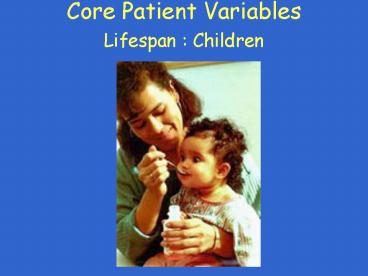Core Patient Variables - PowerPoint PPT Presentation
1 / 26
Title:
Core Patient Variables
Description:
The same indications as for adults except that the dosage is different ... Ventrogluteal site preferred , deltoid may be used. Positive reinforcement ... – PowerPoint PPT presentation
Number of Views:235
Avg rating:3.0/5.0
Title: Core Patient Variables
1
Core Patient Variables
- Lifespan Children
2
- Pharmacotherapeutics indications
- Pharmacodynamics the drugs action
- Pharmacokinectics changes in the drug as it
moves within the body
3
Pharmacotherapeutics(Indications)
- The same indications as for adults except that
the dosage is different - Based on the surface area (m2) or weigh (kgs)
- Surface area is inversely proportional to length
4
- BSA (Weigh in Kg ) X (height in
cm) 3600
Example What is the BSA of a child who weighs
10kgs and is 45 cm tall ?
10 x 45 3600
2
BSA
0.35 m
5
Pharmacodynamics (drug action)
Same as adults however since the organs are not
fully developed yet the response of that organ
to the drug may be diminished. Therefore drug
dosage needs to be adjusted.
6
Pharmacokinetics (drug changes in the body)
- Absorption
- Enteral route infants up to 1 year have less
acidity in the GIT - Parenteral route affected by age due to
- underdeveloped muscles
- erratic blood flow
- However due to increased surface area and skin
permeability enhanced absorption of drugs by
topical route
7
Distribution
- In child this is affected because of difference
in - body fat and water content
- Less plasma proteins
- Immature blood brain barrier
8
- Metabolism
- immature liver leads to decreased
- or incomplete metabolism of some drugs
- liver more probne to hepato toxicity
- Drugs requiring oxidation are more metabolised in
children
9
(No Transcript)
10
- Excretion
- decreased due to immature renal system
- decreased excretion in bile
- Half life is therefore increased
11
(No Transcript)
12
(No Transcript)
13
Contraindications Precautions Cautious
assessment and clinical monitoring when drugs are
given to children since clinical trials are not
conducted on children
14
Adverse Effects
- Allergic reactions
- Idiosnycratic reactions
- Toxic effects due to immature bodily organs
Interactions
- tetracycline
- Glucocorticosteriods
15
Assessment
- Health status
- Developmental level
- Lifestyle / diet / habits
- Environment
16
Health Status
17
Developmental level
- Birth 12 months
- well developed sucking reflex
- vastus lateralis 3 years
- scalp / foot access for I. V needs
18
(No Transcript)
19
- Toddlers 1- 3 years
- resistance to drugs needs to be anticipated
- less resistant to suppositories
- todllers have vivid imaginations but little
knowledge how body works - intra muscular sites vastus lateralis / rectal
femoralis - intravenous sites scalp , avoid foot
20
- Preschoolers 3-5 years
- uncooperative
- Need to offer choices
- Fear of punishment
- ventrogluteal site is preferred dorsogluteal if
necessary - intravenous peripheral sites only
21
- School aged children
- child is very cooperative
- Offer choices
- Avoid rectal suppositories
- Ventrogluteal site preferred , deltoid may be
used - Positive reinforcement
22
- Adolescents ( 13 16 years)
- cooperation is highly developed
- Offer complete explanations
- Privacy and control are importatn issues
- Route same as adult
23
- Lifestyle / diet / habits
- neonate primary intake is milk this affects
gastric pH - Adolescents use of substances such as alcohol,
tobacco and street drugs may affect prescribed
medications
- Environment / culture
- Children requiring drug therapy at home need a
responsible guardian - Religious/cultural beliefs may interfere with
drug therapy
24
- Planning and Intervention
- Oral administration
- Small amounts required use syringe to withdraw
the exact amount - Mix with small amounts of food/ apple sauce
- Parenteral asdministration
- Choices offered must be realistic
- EMLA cream may be used
25
- Rectal administration
- developmental stage needs to be considered
- Intravenous route
- Extra caution to prevent fluid overload
Calculate doses accurately !!!!!
26
- Reducing psychological stress and anxiety
- answer questions simply but truthfully
- parents should be involved
- Ask parents to stroke and comfort child not to
restrain them - give positive remarks to child
- play therapy may be used to educate child































